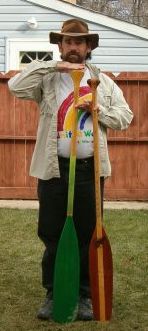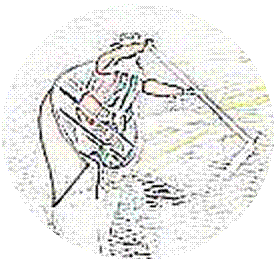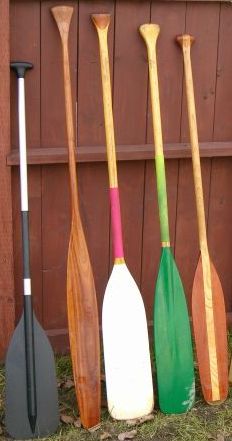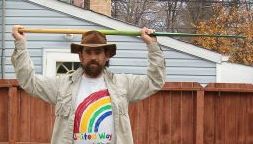
The length and shape of a paddle is a very personal thing and depends on many factors. Body size and purpose are a couple of things to consider but the most important factor, in my opinion, is what works for you as the paddler. If you have a chance try various lengths and styles - not just for a few strokes but whole days or trips. After more than 30 years of serious canoeing I find that I use several different paddle styles and lengths depending on what I want to do.

Paddles don't have to be expensive or made from fancy material to work well. A case in point is my favourite paddle. It is a cheap spruce laminate, like those from Canadian Tire, that I found on a trip in north western Ontario more than 25 years ago; I have used it ever since. This paddle has taken me through many trips, trials and tribulations, high water and low. It has been refinished many times. The last time I refinished the blade I used a green acrylic paint. One of my canoeing friends recently asked why I use that cheap paddle and leave my Red Tail hard wood paddle for a spare. The paddle fits me, or possibly after 25 years I fit the paddle, perfectly.
I don't race canoes and, for me, whitewater is only done to get from one end of the river to the other. My preference is recreational paddling, solo flatwater, and tripping. Spending a periodic afternoon playing in the rapids is fun but I am never going to buy a special play boat and paddle. My suggestions are for people just starting out and interested in recreational paddling.
I do own a number of different paddles and use them all depending
on where I am going and what I am doing. I like plain symmetric wood
paddles because they are warm, comfortable, and versatile. A major consideration
with wood is they require more care then aluminum/plastic paddles.
Several of my whitewater and racing friends have asymmetric paddles
with funny grips, scooped blades, or bent shafts. They also seem to want their paddles made
of weird hightech materials such as carbon fiber with special cores
and fancy composites.

At one time paddle selection was easy - put the tip on the
ground and if it came to your chin, although some people said eyes, then it
was the right length. An alternative was to hold both ends
of the paddle (grip to tip) between your outstretched arms.
These selection methods were used when
virtually all of the mass produced paddles were spruce laminates
made by Clement or were copies of Clement paddles.
Virtually all of the camps that taught canoeing used these
paddles. The shaft length to blade length was basically the same
for all of the paddles available - times have changed.
Look at the the
two paddles I am holding to the right. Using the chin method they are
different lengths but they actually have the same shaft length.


| 
|
Sizing a paddle should be done when actually sitting in a canoe on the water. At the mid-point of a basic forward stroke the blade should be submerged in the water (but not the shaft) and the grip end should not come above your nose or chin. The length of your paddle is very dependent on how you actually paddle, the size and type of canoe you are using, how the seats are placed or how you sit, and your body type and size. The best method for paddle selection is actually taking the paddle on a trip and trying it out. Unfortunately this is not often an option when you are standing in the store looking at that beautiful walnut or cherry blade.
After that long winded introduction how do you select an appropriate starter paddle when standing in the outdoor store? The following suggestions will provide an approximation for the proper length.


None of these methods is perfect and the length should be considered a starting point. In some cases these techniques can return paddle lengths that are quite different. I recently heard from someone with very long arms, in proportion to her body length, where the difference between these methods was considerable. If this is the case you might want to try a paddle length that is intermediate between the, or just use the sitting technique.
If you are paddling classic solo a shorter shafted paddle is better. If you are interested in American freestyle then you might want something longer. Whitewater and some tandem applications require a longer paddle. Larger canoes, or canoes with high seats, require longer paddles. Bent shaft paddles should be a little shorter but give it a try since some people like them long.
I have paddled with people that like really long paddles, and others that like very short paddles. Most of these people have been paddling for years and have worked out a style that is comfortable and meets their needs. Since I started paddling regularly my paddles have been getting shorter. A paddle that is too long will have you digging too deep or holding the paddle grip over your head. It may seem like a little problem in either case but both will cause problems in the long run. Digging deep may mean that you have better reach for braces and more power - great in whitewater. It also means that it is much more difficult to get a good perpendicular stroke which means more pushing down or digging up, and usually more difficult entrance and exits. Finally it puts the blade deeper in the water which can mean digging clams (hitting bottom) in shallow water. Holding the paddle higher means poor body connection and thus poor power. A short paddle on the other hand will have less power and will be of limited use where braces or an extended reach is required. When using a shorter paddle most people will paddle 'hunched' over - poor posture which leads to lack of power and sore tired muscles.
There are some other considerations beyond the length when picking a paddle. The balance point of the paddle should be just above the blade at the throat or neck, near where you hold the paddle. The shape and size of the blade should be matched to the intended purpose and your stength - short and wide for whitewater, narrow and long for deepwater tripping. If this is your first paddle consider an otter tail with a width of 14cm (5.5 inches). Otter tail blades are made for deep water paddling and are rounded and narrow at the tip and broadest near the top (see 'B' above). They are a more forgiving paddle to use than wider standard paddles which can be alittle jarring and tiring to use. Many people enjoy using a beaver tail paddle, a little wider, for the power and additional control it provides. When picking wood paddles choose a laminate where the grain of the wood runs down the paddle with no blemishes, deviations or branch scars. If there is a choice find a lighter paddle - remember you will be carrying it for long periods of time. My preference is for a symmetric pear shaped grip but in white water or where you might want a more positive hold a T grip is a better option. I don't usually recommend asymetric ergonomic grips. The shaft should fit in your hand comfortably, the tip of your index finger should just touch the fleshy part below your thumb (mount of venus). I would suggest starting with a straight shafted paddle (rather than bent shaft) as it will have a wider range of applications and uses.
Over the years I have found that the techniques suggested by Bill Mason fit with mine. It may be that my first canoe teachers were contemporaries of Mr. Mason or by experience they came to the same conclusions. If you want more information on paddles see 'Path of the Paddle' by Bill Mason © 1980, pp 10-11, 14-16 or 'Song of the Paddle' by Bill Mason © 1988 p147.
Another useful article that I have found on the web, some of which contradicts my thoughts, is from John Winters - How to Buy A Paddle. The best common advice is to test the paddle by actually using it in the water with your canoe, and the comments about 'feel'.
There may be other considerations such as blade shape/size, grip type, and shaft diameter that may be important.
Back to Home Page
Back to my Canoe Instruction WWW page
Paddle Manitoba Home Page
If you have any questions or comments please send me Email: burc...@cc.umanitoba.ca